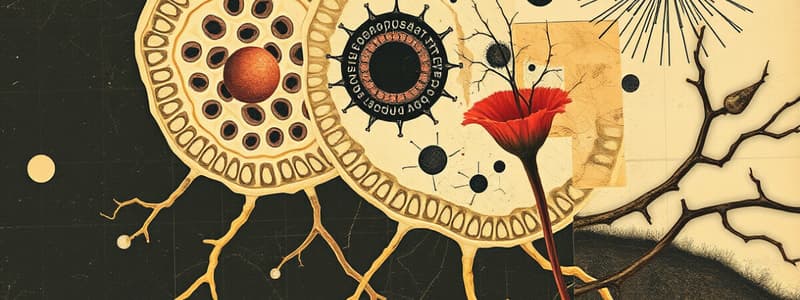Podcast
Questions and Answers
What distinguishes rough endoplasmic reticulum (rough ER) from smooth endoplasmic reticulum?
What distinguishes rough endoplasmic reticulum (rough ER) from smooth endoplasmic reticulum?
- Rough ER is studded with ribosomes. (correct)
- Rough ER is responsible for detoxification.
- Rough ER is primarily involved in lipid synthesis.
- Rough ER has a tubular structure.
What is the primary function of the smooth endoplasmic reticulum?
What is the primary function of the smooth endoplasmic reticulum?
- Translation of mRNA.
- Synthesis of proteins.
- Folding of protein molecules.
- Formation of transport vesicles. (correct)
Where are ribosomes located within the cell?
Where are ribosomes located within the cell?
- Exclusive to the prokaryotic cells.
- Located solely within the nucleus.
- Free floating in the cytoplasm and attached to the rough ER. (correct)
- Only attached to the rough endoplasmic reticulum.
What is the cisternal space in the endoplasmic reticulum primarily responsible for?
What is the cisternal space in the endoplasmic reticulum primarily responsible for?
What type of molecules do ribosomes primarily synthesize?
What type of molecules do ribosomes primarily synthesize?
What is the primary function of the nucleus in a plant cell?
What is the primary function of the nucleus in a plant cell?
Which of the following statements about prokaryotic and eukaryotic cells is accurate?
Which of the following statements about prokaryotic and eukaryotic cells is accurate?
Which organelle in a plant cell is primarily responsible for photosynthesis?
Which organelle in a plant cell is primarily responsible for photosynthesis?
What key advancement in microscopy significantly enhanced the understanding of cell structure?
What key advancement in microscopy significantly enhanced the understanding of cell structure?
Which statement accurately describes a characteristic of both Mitosis and Meiosis?
Which statement accurately describes a characteristic of both Mitosis and Meiosis?
Study Notes
Endoplasmic Reticulum (ER)
- Composed of interconnected, membrane-enclosed structures called cisternae, which serve as reservoirs for liquid.
- The lumen is the internal space within the ER, separated from the cytosol by the ER membrane.
Rough Endoplasmic Reticulum (Rough ER)
- Continuous with the outer nuclear membrane and characterized by ribosomes, giving it a rough appearance.
- Functions include:
- Synthesis, packing, and transport of proteins.
- Folding of proteins in cisternae and transport to the Golgi apparatus.
Smooth Endoplasmic Reticulum (Smooth ER)
- Network of membranous tubules and sacs, lacking ribosomes, resulting in a smooth appearance.
- Functions include:
- Lipid synthesis and transport.
- Carbohydrate metabolism.
- Detoxification of drugs and toxins.
- Contains enzymes that produce and digest lipids and membrane proteins.
Ribosomes
- Present in both prokaryotic and eukaryotic cells, serving as the site for protein synthesis.
- Small, dense structures (20–25 nm) found in the cytoplasm or attached to the rough ER.
- Functions include:
- Site of translation where proteins are synthesized.
- Free ribosomes release proteins into the cytosol; those on rough ER transport proteins to cisternae for the Golgi apparatus.
Plant Cell Characteristics
- Each student is expected to compare and contrast prokaryotic and eukaryotic cells as well as plant and animal cells.
- Key plant cell components include:
- Plasma membrane
- Cell wall
- Cytoplasm
- Endoplasmic reticulum
- Mitochondria
- Ribosomes
- Golgi apparatus
- Plastids (Chloroplasts)
- Importance of understanding the nucleus and cell cycle (mitosis and meiosis) including their stages and significance.
Cell and Microscopy
- Cells are fundamental units of life and can replicate independently; cytology is the study of cells.
- Robert Hooke introduced the term "cell" in 1665 after observing cork cells.
- Cell theory states:
- All living organisms consist of one or more cells.
- New cells arise from the division of pre-existing cells.
- Cells contain genetic material passed from parent to daughter cells.
- All metabolic reactions occur within cells.
Plasma Membrane
- Semi-permeable membrane, allowing selective substance passage.
- Contains receptor proteins for external signaling molecule detection.
Cytoplasm and Cytosol
- Cytoplasm encompasses cytosol and organelles, serving as a site for biochemical reactions.
- Cytosol is a gel-like substance consisting of water, solutes, and cytoskeleton components providing structure and support.
Organelles
- Organelles are membrane-bound structures with specific functions within the cell.
- Essential plant cell organelles include:
- Nucleus
- Mitochondria
- Plastids (including chloroplasts)
- Endoplasmic reticulum
- Ribosomes
- Golgi apparatus
Nucleus
- Central organelle controlling most cellular activities, surrounded by a nuclear membrane.
- Composed of the nuclear envelope, pores, nucleoplasm, nucleolus, and chromatin.
- Functions include genetic information processing and management.
Mitochondria
- Double membrane-bound organelles found in all eukaryotic cells, vital for energy production.
Golgi Apparatus
- Series of flattened membrane-bound sacs (cisternae) responsible for processing and packaging proteins and other molecules.
- Works closely with rough ER: receives proteins from transition vesicles, modifies them, and dispatches them in secretory vesicles.
Vacuole/Central Vacuole
- Fluid-filled organelles enclosed by tonoplast, regulating ion, water, and nutrient movement.
- Functions vary based on the abundance and activity of membrane proteins.
Studying That Suits You
Use AI to generate personalized quizzes and flashcards to suit your learning preferences.
Related Documents
Description
Explore the structure and function of the endoplasmic reticulum in this quiz. Learn about the rough and smooth types of ER, their roles in cellular processes, and the significance of cisternae and lumen. Test your knowledge on these vital organelles.





